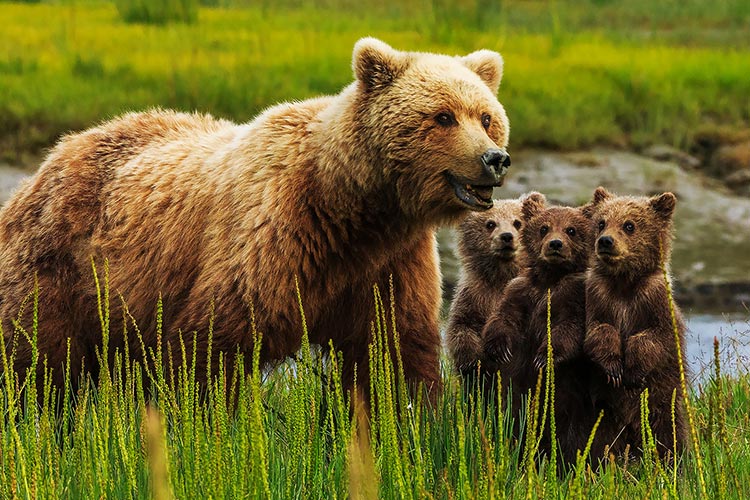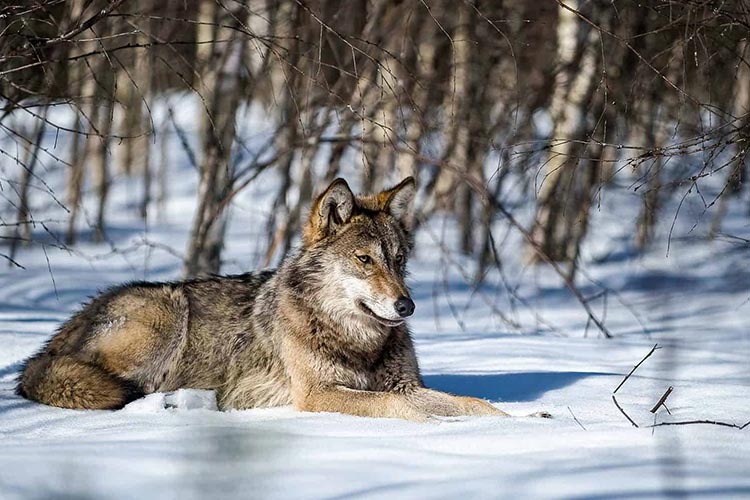Parco Nazionale d’Abruzzo, Lazio e Molise – For centuries this was Italy’s most isolated wilderness, and notoriously shy bears and wolves still roam amid its towering peaks, silent green valleys, cobalt-blue lakes and thick forest.
Wild poppies flame from the foothills in spring as you approach the Parco Nazionale d’Abruzzo, Lazio e Molise. Gentle hills give way to steeper slopes, rearing up to the highest points of the Apennine range. Glacial and fluvial gorges trace the violent geological activity that has created these peaks, troughs and chasms. Remote sanctuaries punctuate forgotten-feeling high-altitude valleys, ideal points to contemplate the vastness of nature and your smallness within it.
Lago and Tratturi
Mountain-edged valleys cup lakes that reflect the peaks in their mirrored waters. The small scoop of Lago Vivo partly freezes in the winter chill. A herd of deer scatters as you follow a path upwards. Occasionally you’ll pass snub-roofed drystone huts, still used by farmers and shepherds as their livestock roam across the hills. Beech trees dominate the forests, their leaves turning gold, rust and terracotta-red in autumn.
Such was the isolation of the area that it was for a long time almost inaccessible. Tratturi (long grassy paths) weave across the countryside, linking the Apennines to Puglia in the south. These still-in-use routes were used by the pre-Roman Samnite population and later the Romans. From the 1400s to the 1970s shepherds drove their flocks along these twice annually. In autumn they travelled from the highlands to balmier grazing in Apulia in Italy’s deep south, returning up to the cooler pastures in summer. This was the annual transhumance, and today walkers can trace their footsteps across these ancient routes.
In 1922, the (then) 5 sq km park was founded to protect the area’s rare natural riches, from bears to orchids, born of its isolation and inaccessibility, but the Fascists abolished the park in 1933. Following the park’s re-establishment in 1950, it was gradually expanded to cover the vast, epically wild and diverse 500 sq km of today.
Parco Nazionale d’Abruzzo – When to go
Wild flowers carpet the park from April to June. While in similarly temperate Sep- tember to October the vast forest turns magnificently gold and red. July and August are hot, and winter’s cold and snowy, prime time for winter sports.
Parco Nazionale d’Abruzzo – Getting there
In central Italy, the park is accessible via bus from Avezzano (for connections to L’Aquila, Pescara and Rome), to Pescasseroli, Civitella Alfedena and other villages. The A24 and A25 highways are the closest major roads.
Park in numbers
440 Area covered (sq km)
2249 Highest point: Petroso (m)
60 Percentage covered by forest
Parco Nazionale d’Abruzzo – Stay here
Albergo Antico Borga La Torre
Up a stepped cobbled lane, this 18th-century town house has small geranium-laden balconies. It’s in the medieval centre of Civitella Alfedena, a red-roofed, pale-walled small town that spills across the wooded landscape at the foot of a string of Apennine peaks. Rooms have pine furnishings and an old-school feel, and superb panoramas lift them out of the ordinary. The small restaurant serves hearty local dishes to set you up for the hills. Usually with some homemade liquor to finish.
B&B Animali Selvaggi
In Pescasseroli, this three-bedroom guesthouse has rooms featuring polished- wood antique furniture that belonged to the owners’ grandparents. It’s also eco-friendly, and all the food for breakfast is organic, plus it caters for vegans.
B&B La Sosta
This whitewashed B&B is on the main road below the small town of Opi, which cloaks a hilltop below higher peaks. It’s run by a welcoming elderly couple who take pride in their hospitality, offering smart, well-cared-for rooms with balconies.
Parco Nazionale d’Abruzzo – Do this
Bear watching
One of the many thrilling adventures to be had in the park is to take bear-watching excursions with local operators. Some offer middle-of-nowhere accommodation for better bear spotting, in remote mountain lodges set amid snowcapped peaks and emerald-green grassy hills. At dusk or in the early morning, as the sun rises and turns the surrounding colours golden, you’ll venture out to track and observe bears with an expert local guide, exploring the ancient woodlands, grassy clearings and hidden crevices that are the favourite spots of these retiring creatures.

Wolf howling
Wolf howling was a technique used by hunters in the past. Local operator Eco- tur has adopted this method as a way of discovering more about wolves, offering evening treks to hear the howl of the wolf.
Horse riding and donkey trekking
Exploring the park’s pristine wilderness on horseback or taking it slowly by donkey feels like a link to the past as well as a way to cover a lot of ground while enjoying the unmotorised peace.
Parco Nazionale d’Abruzzo – Hike
Val di Rose to Rifugio di Forca Resuni
A gentle, waymarked three-hour walk, this popular trail runs through glorious, goat- and deer-dotted forested countryside.
Monte Amaro route
The climb to this peak (2793m), just outside the park, takes 2¼ hours and offers soul-stirring views over the woodlands and gullies of Valle di Sangro, and a strong possibility of spotting chamois.
Monte Tranquillo and the Rocca Ridge
This route up Monte Tranquillo (1658m) is around a 2½-hour walk, and from here
you can continue north along the challenging, top-of-the-world Rocca Ridge, a 19.5km circuit.
Parco Nazionale d’Abruzzo – What to spot…
The park is two-thirds forest, mostly beech, with other foliage including black pine and silver birch. Species such as the chamois, the Marsican brown bear and the Apennine wolf roam the inhospitable-seeming landscape. The densely forested hills hide wild boar, and roe and red deer. While smaller mammals include martens, otters, badgers and polecats. You’re most likely to see squirrels, dormice, hedgehogs, moles, weasels, hares and foxes. Whirring above are sparrow hawks, kestrels, buzzards, peregrine falcons and golden eagles.
ABRUZZO CHAMOIS
Part goat, part deer, this variety of chamois had almost died out when the park was established. With just a few dozen left, but the population now numbers over 2000.
MARSICAN BROWN BEAR
This quiet, solitary, imposing creature, which can weigh up to 200kg, feeds on fruit, plants, insects, honey and small animals. There are around 100 in the park.
ITALIAN WOLF
A grey-wolf subspecies, this wolf is particular to the Apennines.
Roaming in smaller packs than their foreign relatives, by night they feed on chamois, roe deer, red deer, wild boar, hares and rabbits.

Parco Nazionale d’Abruzzo – Itineraries
Take trails deep into this wildest and most untouched-feeling of Italian landscapes. Lis- tening out for wolves, tracking bears or gliding serenely across mountain lakes.
Parco Nazionale d’Abruzzo – A day
Despite the impenetrable atmosphere of the park, you can explore a thrilling swathe of its mountains, forest and lakes in a day. Start your exploration from the headquarters of the national park, the town of Pescasseroli, which lies in the upper valley of the Sangro River, backed by thickly wooded hills.
After parking your car in the car park, try one of the short trails cobwebbing out in all directions (maps are available from the town). You’ll soon be immersed in the peace, birdsong and sumptuous natural splendour of the national park, with towering peaks plummeting down into forested valleys.
After your walk is done, hop back in the car for the 7km drive to Opi, a medieval town perched on a rocky promontory with views over the surrounding thickly wooded countryside, and eat a meal featuring local mountain produce, comprising ingredients such as lamb, truffles and wild mushrooms, at one of the local restau- rants, or unwrap a picnic lakeside at your next destination.
Finish your day trip at Barrea, 13km further on, a magical-looking red-roofed town that clings to the steep, wooded lakeside. The deep blue waters of vast Lake Barrea appear to have been here for millennia. But the lake was created by damming the river after WWII.
There are lake beaches or you can hire boats so that you can complete your day gliding across the water, walls of mountains on every side.
Parco Nazionale d’Abruzzo – Two days
For this slower route around Abruzzo National Park, once again start at the small town of Pescasseroli, where you can consult the local visitor centre to help decide which of the park’s 150 walking trails you fancy, or arrange wolf- or bear-spotting excursions. Next, head on to Opi.
From this town you can take a 2½-hour walk through Valle di Fondillo. Past thickly wooded areas alive with wildlife – there’s a chance you’ll see chamois, and possibly bears (they’re shy, but keep quiet, calm and at a distance).
You could also climb Monte Amaro (Bitter Mountain; 2793m), one of the highest Apennine peaks (it lies just outside the park, in Maiella National Park), for heart-in-mouth, moonscape views. At your third stop, make a base in Civitella Alfedena, a higgledy-piggledy village on a wooded hilltop above Barrea Lake.
Choose a walking trail from the town, such as around the Val di Rosa, a forested valley that offers the best chance of spotting the park’s graceful herds of chamois. On your final day, take a beautiful journey to Scanno, just outside the protected area, past the Lago di Scanno, a rippling mirror of blue-green lake.
The road from the lake runs through the Gole di Sagittario, a chasm hemmed in by vast walls of rock, and snakes above the turquoise waters of the Sagittario river. If the villages clinging almost surreally to the hillsides remind you of works by Dutch artist MC Escher, you’re on to something: he drew the town of Castrovalva near here.

